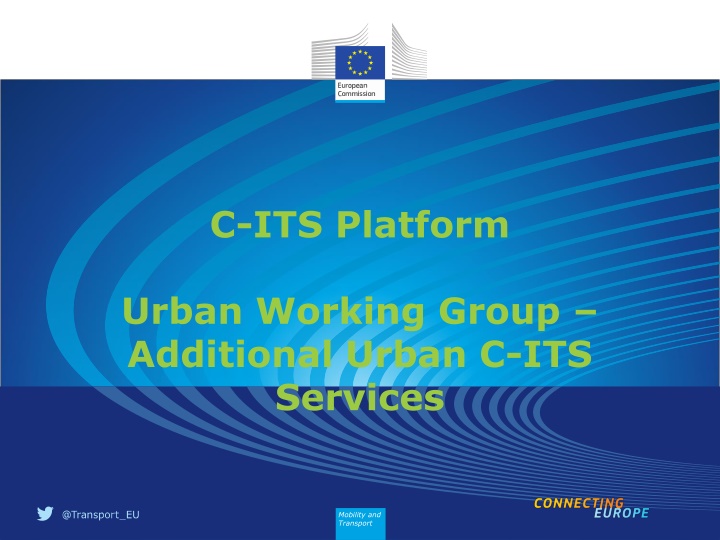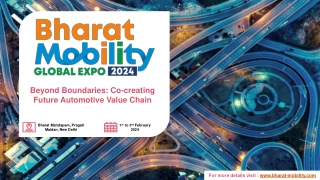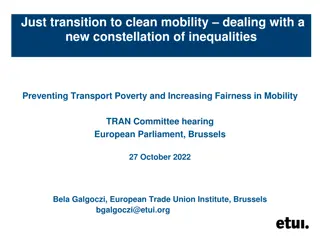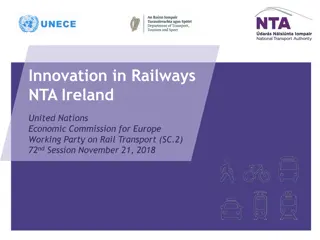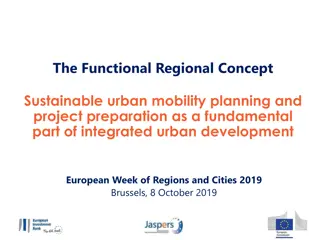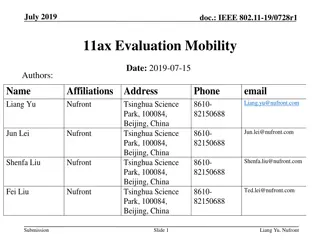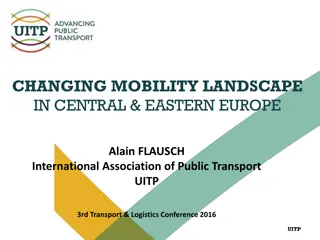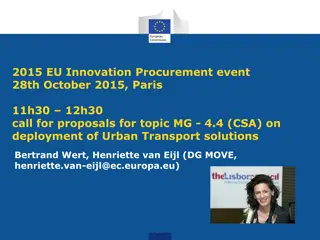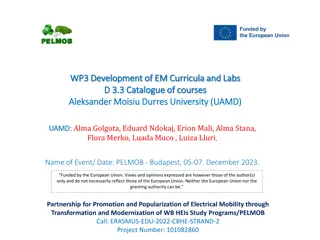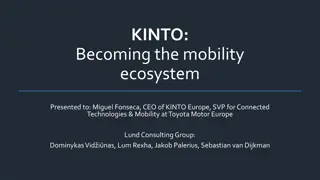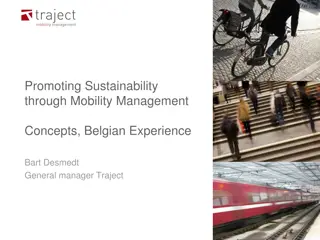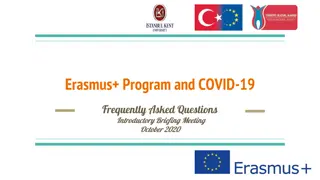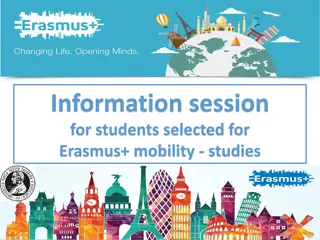Urban C-ITS Services for Enhanced Mobility and Transport Management
Urban C-ITS (Cooperative Intelligent Transport Systems) Working Group discusses additional services for improving mobility and transport in urban areas. Outcomes of meeting 1 include various C-ITS services like traffic signal priority, green light optimization, traffic information, and more. The categories of additional C-ITS services encompass new urban-specific services, extended functionalities, and additional user groups. Access zone management, public transport prioritization, parking management, and collaborative traffic management are highlighted as crucial elements. The focus is on enhancing safety, efficiency, and sustainability in urban transportation through innovative solutions.
Download Presentation

Please find below an Image/Link to download the presentation.
The content on the website is provided AS IS for your information and personal use only. It may not be sold, licensed, or shared on other websites without obtaining consent from the author.If you encounter any issues during the download, it is possible that the publisher has removed the file from their server.
You are allowed to download the files provided on this website for personal or commercial use, subject to the condition that they are used lawfully. All files are the property of their respective owners.
The content on the website is provided AS IS for your information and personal use only. It may not be sold, licensed, or shared on other websites without obtaining consent from the author.
E N D
Presentation Transcript
C-ITS Platform Urban Working Group Additional Urban C-ITS Services Mobility and Transport
Recap: Outcomes of Meeting 1 Level C-ITS Service Score Day 1 TRAFFIC SIGNAL PRIORITY REQUEST BY DESIGNATED VEHICLES 14 Day 1 GREEN LIGHT OPTIMIZED SPEED ADVISORY GLOSA/TIME TO GREEN (TTG) TRAFFIC INFORMATION AND SMART ROUTING PARK AND RIDE INFORMATION ROAD WORKS WARNING IN-VEHICLE SPEED LIMITS PROBE VEHICLE DATA VULNERABLE ROAD USER PROTECTION 12 Day 1.5 Day 1.5 Day 1 Day 1 Day 1 Day 1.5 10 9 6 6 6 6 Did not pass threshold* Signal violation/intersection safety, On street parking information and management, Weather conditions, Information on AFV stations and charging points, Traffic jam ahead warning, Other hazardous notifications, In-vehicle signage, Off street parking information, Connected & Cooperative navigation into and out of the city, Slow or station vehicle(s), Emergency electronic brake light, Emergency vehicle approaching, Shockwave damping. Mobility and Transport
Categories of Additional C-ITS Services 1. New Urban Specific Services 2. Extended Functionality of Original List of Day 1/1.5 Services 3. Additional User Groups of Existing C-ITS Day 1/1.5 Services Mobility and Transport
Access Zone Management (restricted lanes, zones, tunnes/bridges, management of freight loading/unloading areas) Access management of speed (i.e. near schools or identified priority zones by local authority etc.) - subset of in-vehicle signage Public Transport Vehicle Approaching Temporay traffic light prioritisation for designated vehicles (large events like concerts, football games etc.) - subset of traffic light prioritisation of designated vehicles On-street and off-street parking management - subset of on-street and off-street parking information Collaborative perception of Vulnerable Road Users (VRUs) - subset of VRU road user protection Collaborative Traffic Management - subset of connected, cooperative navigation into and out of the city GLOSA for cyclists Mobility and Transport
Access Zone Management (restricted lanes, zones, tunnes/bridges, management of freight loading/unloading areas) Access management of speed (i.e. near schools or identified priority zones by local authority etc.) - subset of in-vehicle signage On-street and off-street parking management - subset of on-street and off-street parking information Public Transport Vehicle Approaching Temporay traffic light prioritisation for designated vehicles (large events like concerts, football games etc.) - subset of traffic light prioritisation of designated vehicles Collaborative Traffic Management - subset of connected, cooperative navigation into and out of the city Collaborative perception of Vulnerable Road Users (VRUs) - subset of VRU road user protection GLOSA for cyclists - Service descriptions, roles and responsibilities, technical requirements defined in WG deliverables - C-ITS Platform Phase II Report to include this set of extension of urban relevant C-ITS services (subject to June Plenary) Mobility and Transport
This project has received funding from the European Union s Horizon 2020 research and innovation programme under grant agreement No 653637 CONNECTED VEHICLES: THE URBAN IMPACT THE CIMEC PROJECT
CIMEC MOTIVATION Deployment barriers are not technical Deployment in cities is not keeping pace with the highways Deployment should happen in an open market place Deployment should be simple and integration automatic 7
CIMEC OBJECTIVES Gain better understanding of the challenges, enablers and barriers, and strategies for use of C- ITS solutions in European cities Capture and document a set of realistic use cases for C-ITS in cities Identify how emerging standards for C-ITS will affect, and should respond to, the systems and processes in the urban environment Promote multi-sector stakeholder dialogue, engagement and collaboration 8
CITY PERSPECTIVE ON C-ITS What cities want: To reduce congestion To improve the environment specifically regarding air pollution To maintain safety on the network To improve accessibility by promoting excellent public transport (partly to support the above goals) 9
CITY PERSPECTIVE ON C-ITS Cities lack knowledge about: What products are available Which products will work with each other, or with the systems that will be acquired by road users The cost of acquiring or operating products 10
CITY PERSPECTIVE ON C-ITS Cities need to be convinced that the technology: Is available and meets the specification Will do the job better than another (cheaper) solution Is well tested to achieve the outcome desired Is well tested to be safe in the context Is a price which is manageable within the budget Will integrate with the city s own legacy systems Is future-proofed against obsolescence 11
URBAN C-ITS USE CASES C-ITS use cases with potential for cities: Identified through workshops and surveys involving local city authorities and stakeholders Supplemented with relevant use cases from the other projects Mix of general and more specific categories, with some overlap
URBAN C-ITS USE CASES Information to road users UC1: Individual routing of vehicles UC2: In-vehicle signs UC3: In-vehicle signal information UC12: Inform about incidents in the road network and access control to these areas UC13: Inform about emergencies in the road network and access control to these areas Traffic light management UC8: Traffic light management UC7: Green lights for police and emergency vehicles UC9: Green lights for public transport vehicles UC10: Green lights for cyclists Access control UC5: Access control for heavy goods vehicles with dangerous goods UC6: Regulation of access to free lanes for electrical vehicles UC14: Dynamic access control for air quality management 13
URBAN C-ITS USE CASES Vulnerable road users (VRUs) UC10: Green lights for cyclists UC15: Speed enforcement around schools UC16: C-ITS services for vulnerable road users UC17: Pedestrians crossing in front of bus/tram UC18: Bike lane change and unusual crossing Parking management UC11: Parking management UC7: Green lights for police and emergency vehicles Emergency vehicles Freight vehicles UC4: Management of loading and unloading areas for freight vehicles UC5: Access control for heavy goods vehicles with dangerous goods 14
RECOMMENDATIONS FOR CITIES As soon as realistic C-ITS products become available: Start working on a strategy for optimizing C-ITS potential by means of: Communication channels Roadside units Central data bases Open data feeds shared technology platforms shared approach for business models Role of suppliers of: technology data services 15
BUSINESS MODELS City collect data and provide service directly to the road user, using its own technology - No third party involved Third party collect data and provide service - No direct city involvement Third party provide service on behalf of city - city collect data for own use Third party collect and provide data to the city - city provide service to the road user Feasibility; political, technical and commercial Utility; to road users and city managers Social and legal issues - privacy 16
UNDERSTANDING THE COSTS Cost of acquiring (or upgrading) roadside devices Cost of installing and commissioning roadside devices Cost of acquiring (or upgrading) central systems, including the additional cost of integration of roadside devices (Additional) cost of the city s communication network between centre and roadside; also possibly additional costs of electricity supply Cost of acquiring and/or training staff to use the system Cost of maintenance, repair, upgrade and replacement of system elements Any direct contribution to the cost of in-vehicle systems in the case of city vehicles, the whole cost Cost of marketing to prospective road users Cost of technical support to actual road users Potential costs associated with consequences such as complaints and claims 17
SUPPLIER READINESS In general suppliers see potential in city C-ITS... A few key suppliers have a clear vision and an action plan for deployment And they don t reveal much information! Most have no well-defined plan investment in product development will be limited as long as: Their current ITS-market position is not in danger There is no clear business case for city C-ITS They still face too many challenges (technical, political, legal, etc.) 18
RISK Breach of privacy Accident liability Political risk (e.g. through poor public reception) Supply failure Imposition of excessive costs or other burdens on road users Operational inadequacy (e.g. through shortage of skilled staff) 19
EXTERNAL FACTORS Automated/autonomous vehicles degree of interaction with C-ITS city role: control or merely inform the vehicle? Personal smart devices Intelligent Mobility (IM) Mobility as a Service (MaaS) Smart cities Broader city strategies for use of technology - transport being one area "Internet of Things" (IoT) Newer transport modes Powered two-wheelers (PTW) 20
THE WIDER CONTEXT Cities future obligations to implement specific C- ITS services, and specifications of these services Support arrangements to ensure coherence, and long term stability of these Legal developments Private sector developments Vehicle telematics Vehicle autonomy Smart personal devices Evidence of benefits Support mechanisms Sustainability Cost-efficiency Funding Implementation 21
RECOMMENDATIONS FOR AUTHORITIES Establish base of evidence for benefit from urban C-ITS projects pilots Support and ensure coordination and communication involving cities, advisers and suppliers European level National/regional level Harmonised city approach to C-ITS a market for urban C-ITS 22
OUR PARTNERS 23
Thank you! 24
